Modeling and Performance Analysis of a Solar Pond Integrated with an Absorption Cooling System
Abstract
:1. Introduction
2. Methodology
3. Mathematical Modeling
3.1. Solar Pond Subsystem
3.2. Absorption Subsystem
3.3. The Overall System
4. Results and Discussion
4.1. Solar Pond Subsystem
4.1.1. Optimizing the NCZ Thickness with Respect to the Extraction Rate and Efficiency
4.1.2. Optimizing of the NCZ Thickness with Respect to the LCZ Temperature
4.1.3. Effect of Annual Average Global Radiation and Annual Average Ambient Temperature on the Performance of the Pond
4.1.4. Effect of Average Global Radiation and Ambient Temperature on the LCZ Temperature
4.2. Absorption Subsystem
4.2.1. Optimization of the Performance of Absorption Chiller with Respect to Generator and Evaporator Temperatures
4.2.2. Optimization of the Performance of the Absorption Subsystem with Respect to the Cooling Temperature
4.3. Performance of Overall System
4.3.1. Effect of Hot Source Temperature on the Performance of the Overall System
4.3.2. Effect of Environmental Conditions on the Performance of the Overall System
4.3.3. Effect of Evaporator Temperature on the Performance of the Overall System
4.4. Model Validation
5. Conclusions and Recommendations
- Coupling a solar pond with an absorption chiller results in a system that is reliable and sustainable and ideally suited to hot areas such as Jordan and countries with similar weather. This coupling is useful in facing two difficulties arising from characteristics of solar radiation, its low energy density and its irregularity;
- Careful selection of the rate of heat extraction rate from the pond helps in maintaining the temperature of the pond storage layer in the range of 75–95 °C, which is suitable for efficient chiller operation over long periods of time;
- By choosing an appropriate place to implement the proposed system, such as the Dead Sea area in Jordan, which has favorable climatic conditions, a 3000 m2 surface area solar pond coupled with an absorption chiller was optimized and was able to supply a heat flow rate of 158.5 kW with an efficiency of 0.23. The chiller was able to produce a cooling capacity of 126.3 kW with a coefficient of performance of 0.797; therefore, the overall system coefficient of performance was equal to 0.183;
- If the temperature of LCZ and the thickness of NCZ are fixed, the heat extraction rate and the efficiency of the pond increase with the annual average global solar radiation and with the annual average ambient temperature;
- If the heat extraction rate and the thickness of the NCZ are fixed, the temperature of LCZ increases with the annual average global solar radiation and with the annual average ambient temperature;
- If the heat extraction rate is fixed, there is a certain thickness at which the LCZ temperature takes a maximum value;
- Both the COP and of the absorption unit increase with hot source temperature to reach optimum values and then show a gradual decrease and both are characterized by high stability over a wide range of temperature variations between 75 and 95 °C;
- Both the COP and of the absorption unit are slightly affected as long as the condenser and absorber temperatures are below 40 °C;
- The proposed method of cooling the condenser and the absorber helps to avoid reaching the point of deterioration in the performance of the chiller and eliminates the need for use of a cooling tower;
- With the increase in the hot source temperature, the efficiency of the solar pond decreases while the COP of the absorption chiller increases so that the COP of the overall system takes a maximum and optimum value at a certain temperature;
- The COP of the overall system has a high level of stability over a wide range of hot source temperatures and takes a maximum value of 0.187 at a temperature of 75 °C;
- Both the COP and cooling capacity of the overall system increase with average global radiation while the increase in average ambient temperature has two opposite effects, one increases the efficiency of the pond and the other reduces the performance of the chiller;
- At low values of ambient temperature, the system performs better at lower hot source temperatures while the opposite happens at higher values of ambient temperature;
- There is an inverse relationship between the rate of increase in the coefficient of performance of the overall system with evaporator temperature and hot source temperature, such as both values can be controlled simultaneously to increase the performance of the system;
- The prediction of the model showed good agreement with the experimental results as the deviations of model results for the solar pond were within 3.6% and for the absorption chiller were within 1.78%;
- In light of the results that were reached, it is recommended to conduct further research that includes the implementation of an experimental system to carefully evaluate the performance and feasibility of the proposed system in real working conditions and to analyze the effects of the key parameters that govern the overall efficiency. More research is needed on the technical and economic optimization of pond and chiller sizes depending on real conditions, such as changes in temperature and solar radiation. Finally, it is recommended to initiate performance and economic studies to determine the potential for use of the system in specific applications, such as residential heating and cooling systems, and to identify the steps to be taken towards developing the system from the research phase to the commercial phase.
Funding
Data Availability Statement
Conflicts of Interest
Nomenclature
| A,B,C | constants |
| Aj | constants related to light absorption |
| Ap | pond surface area (m2) |
| c1, c2 | constants of integration |
| COP | coefficient of performance |
| COPov | overall system performance |
| h | specific enthalpy (kJ/kg) |
| annual average global solar radiation (Wm−2) | |
| k | fluid thermal conductivity (Wm−1K−1) |
| Kj, K′j | constants related to light absorption (m−1) |
| l1 | upper Convective Zone thickness (m) |
| l2 | non-Convective Zone thickness (m) |
| L | pond total depth (m) |
| mass flow rate (kg/s) | |
| n1, n2 | refraction indices of first and second mediums |
| annual average heat extracted rate (W) | |
| heat flow rate (kW) | |
| T | temperature (°C) |
| annual average temperature of UCZ (°C) | |
| annual average temperature of NCZ (°C) | |
| annual average temperature of LCZ (°C) | |
| x | depth of water (m), mass fraction of lithium bromide, (kg LiBr/kg solution) |
| Greek Letters | |
| δ | declination angle |
| εHE | heat exchanger effectiveness |
| annual average pond efficiency | |
| θ1 | effective angle of incidence for annual average values |
| θ2 | refraction angle |
| λ | solar radiation wavelength (µm) |
| ρb | beam radiation reflectivity |
| δ | declination angle |
| τa | transmissivity based on absorption |
| τr | transmissivity based on reflection |
| φ | latitude |
| ω | hour angle, frequency (Hz) |
| Subscripts | |
| a | absorber |
| amb | ambient |
| c | condenser |
| e | evaporator |
| g | generator |
| i | state point or index i = 1, 2, 3… |
| r | refrigerant |
| ss | strong solution |
| ws | weak solution |
| Abbreviations | |
| A | absorber |
| C | condenser |
| E | evaporator |
| G | generator |
| HE | solution heat exchanger |
| LCZ | lower convective zone |
| NCZ | non-convective zone |
| UCZ | upper convective zone |
| SGSP | salinity gradient solar pond |
References
- Alcaraz, A.; Montalà, M.; Cortinaa, J.L.; Akbarzadeh, A.; Aladjem, C.; Farran, A.; Valderran, A. Design, construction, and operation of the first industrial salinity-gradient solar pond in Europe: An efficiency analysis perspective. Sol. Energy 2018, 164, 316–326. [Google Scholar] [CrossRef]
- Amigo, J.; Suárez, F. Ground heat storage beneath salt-gradient solar ponds under constant heat demand. Energy 2018, 144, 657–668. [Google Scholar] [CrossRef]
- Saleh, A.; Qudeiri, J.A.; Al-Nimr, M.A. Performance investigation of a salt gradient solar pond coupled with desalination facility near the Dead Sea. Energy 2011, 36, 922–931. [Google Scholar] [CrossRef]
- Weinberger, H. The physics of the solar pond. Sol. Energ 1964, 8, 45–46. [Google Scholar] [CrossRef]
- Rabl, A.; Neilsen, C.E. Solar ponds for space heating. Sol. Energ 1975, 17, 1–12. [Google Scholar] [CrossRef]
- Kooi, C.F. The steady state salt gradient solar pond. Sol. Energ 1979, 2, 37–45. [Google Scholar] [CrossRef]
- Verma, S.; Das, R. Effect of ground heat extraction on stability and thermal performance of solar ponds considering imperfect heat transfer. Sol. Energy 2020, 198, 596–604. [Google Scholar] [CrossRef]
- Hawlader, M.N.A.; Brinkworth, B.J. An analysis of the non-convecting solar pond. Sol. Energy 1981, 27, 195–204. [Google Scholar] [CrossRef]
- Tian, D.; Qu, Z.G.; Zhang, J.F.; Ren, Q.L. Enhancement of solar pond stability performance using an external magnetic field. Energy Convers. Manag. 2021, 243, 114427. [Google Scholar] [CrossRef]
- Boudhiaf, R.; Ben Moussa, A.; Baccar, M. A Two-Dimensional Numerical Study of Hydrodynamic, Heat and Mass Transfer and Stability in a Salt Gradient Solar Pond. Energies 2012, 5, 3986–4007. [Google Scholar] [CrossRef]
- Anagnostopoulos, A.; Sebastia-Saez, D.; Campbell, A.N.; Arellano-Garcia, H. Finite element modelling of the thermal performance of salinity gradient solar ponds. Energy 2020, 203, 117861. [Google Scholar] [CrossRef]
- Lu, H.; Walton, J.C.; Swift, A.H.P. Desalination coupled with salinity-gradient solar ponds. Desalination 2001, 136, 13–23. [Google Scholar] [CrossRef]
- Duffie, J.A.; Beckman, W.A.; Blair, N. Solar Engineering of Thermal Processes, Photovoltaics and Wind, 5th ed.; John Wiley & Sons, Inc.: Hoboken, NJ, USA, 2020. [Google Scholar]
- Ullah, K.R.; Saidur, R.; Ping, H.W.; Akikur, R.K.; Shuvo, N.H. A review of solar thermal refrigeration and cooling methods. Renew. Sustain. Energy Rev. 2013, 24, 499–513. [Google Scholar] [CrossRef]
- Fathi, R.; Gumimi, C.; Ouaskit, S. An irreversible thermodynamic model for solar absorption refrigerator. Renew. Energy 2004, 29, 1349–1365. [Google Scholar] [CrossRef]
- Saleh, A.; Mosa, M. Optimization study of a single-effect water–lithium bromide absorption refrigeration system powered by flat-plate collector in hot regions. Energy Convers. Manag. 2014, 87, 29–36. [Google Scholar] [CrossRef]
- Ren, J.; Qian, Q.; Yao, Z.; Gan, N.; Zhang, Y. Thermodynamic Evaluation of LiCl-H2O and LiBr-H2O Absorption Refrigeration Systems Based on a Novel Model and Algorithm. Energies 2019, 12, 3037. [Google Scholar] [CrossRef] [Green Version]
- Abid, M.; Khan, M.S.; Tahir, T.A.H.; Malik, M.N.; Ali, H.M.; Cheok, Q. Thermodynamic analysis and comparison of different absorption cycles driven by evacuated tube solar collector utilizing hybrid nanofluids. Energy Convers. Manag. 2021, 246, 114673. [Google Scholar] [CrossRef]
- Saleh, A.; Al-Nimr, M.A. A novel vacuum wastewater treatment plant integrated with a solar absorption system. Int. J. Energy Res. 2020, 44, 1685–1697. [Google Scholar] [CrossRef]
- Al-Falahi, A.; Alobaid, F.; Epple, E. Design and Thermo-Economic Comparisons of an Absorption Air Conditioning System Based on Parabolic Trough and Evacuated Tube Solar Collectors. Energies 2020, 13, 3198. [Google Scholar] [CrossRef]
- Alrwashdeh, S.S.; Alsaraireh, F.M.; Saraireh, M.A. Solar radiation map of Jordan governorates. Int. J. Eng. Technol. 2018, 7, 1664–1667. [Google Scholar] [CrossRef]
- Tsilingiris, P.T. Large scale solar cooling design using salt gradient solar ponds. Renew. Energy 1991, 1, 309–314. [Google Scholar] [CrossRef]
- Tsilingiris, P.T. The absorption chiller in large scale solar pond cooling design with condenser heat rejection in the upper convecting zone. Sol. Energy 1992, 49L, 19–27. [Google Scholar] [CrossRef]
- Kanan, S.; Dewsbury, J.; Lane-Serff, G.F. Simulation of Solar Air-Conditioning System with Salinity Gradient Solar Pond. Energy Procedia 2015, 79, 746–751. [Google Scholar] [CrossRef]
- Salata, F.; Tarsitano, A.; Golasi, I.; Vollaro, E.L.; Coppi, M.; Vollaro, A.L. Application of Absorption Systems Powered by Solar Ponds in Warm Climates for the Air Conditioning in Residential Buildings. Energies 2016, 9, 821. [Google Scholar] [CrossRef] [Green Version]
- Chakrabartya, G.S.; Wankhedea, U.S.; Shelkea, R.S.; Gohilc, T.B. Investigation of temperature development in salinity gradient solar pond using a transient model of heat transfer. Sol. Energy 2020, 202, 32–44. [Google Scholar] [CrossRef]
- Kasaeian, A.; Sharifi, S.; Yan, W. Novel achievements in the development of solar ponds: A review. Sol. Energy 2018, 174, 189–206. [Google Scholar] [CrossRef]
- Chevallier, J.; Isern, L.; Almandoz, F.K.; Chalk, C.; Nicholls, J.R. Modelling evaporation in electron-beam physical vapour deposition of thermal barrier coatings. Emergent Mater. 2021, 4, 1499–1513. [Google Scholar] [CrossRef]
- Ayou, D.S.; Coronas, A. New Developments and Progress in Absorption Chillers for Solar Cooling Applications. Appl. Sci. 2020, 10, 4073. [Google Scholar] [CrossRef]
- Stocker, W.; Jones, J.W. Refrigeration and Air Conditioning; McGraw Hill: Singapore, 1982. [Google Scholar]
- ASHRAE. ASHRAE Handbook of Fundamentals; ASHRAE: Atlanta, GA, USA, 1985. [Google Scholar]
- Climate Conditions in Dead Sea. Available online: http://hikersbay.com/climate-conditions/israel/deadsea/climate-conditions-in-dead-sea.html?lang=en#weather-temperature-months (accessed on 5 October 2022).
- Hull, J.; Nielsen, C.E.; Golding, P. Salinity Gradient Solar Ponds; CRC Press: Boca Raton, FL, USA, 1989. [Google Scholar]
- Worlddata.info. Available online: https://www.worlddata.info/asia/jordan/climate.php (accessed on 5 October 2022).
- Kaynakli, O.; Kilic, M. Theoretical study on the effect of operating conditions on performance of absorption refrigeration system. Energy Convers. Manag. 2007, 48, 599–607. [Google Scholar] [CrossRef]
- Aphornratana, S.; Sriveerakul, T. Experimental studies of a single-effect absorption refrigerator using aqueous lithium-bromide: Effect operating condition to system performance. Exp. Therm. Fluid Sci. 2007, 32, 658–669. [Google Scholar] [CrossRef]
- Çengel, Y.A.; Ghajar, A.J. Heat and Mass Transfer: Fundamentals & Applications, 5th ed.; McGraw-Hill Education: New York, NY, USA, 2015; pp. 882–883. [Google Scholar]
- Leblanc, J.; Akbarzadeh, A.; Andrews, J.; Lu, H.; Golding, P. Heat extraction methods from salinity-gradient solar ponds and introduction of a novel system of heat extraction for improved efficiency. Sol. Energy 2011, 85, 3103–3142. [Google Scholar] [CrossRef]


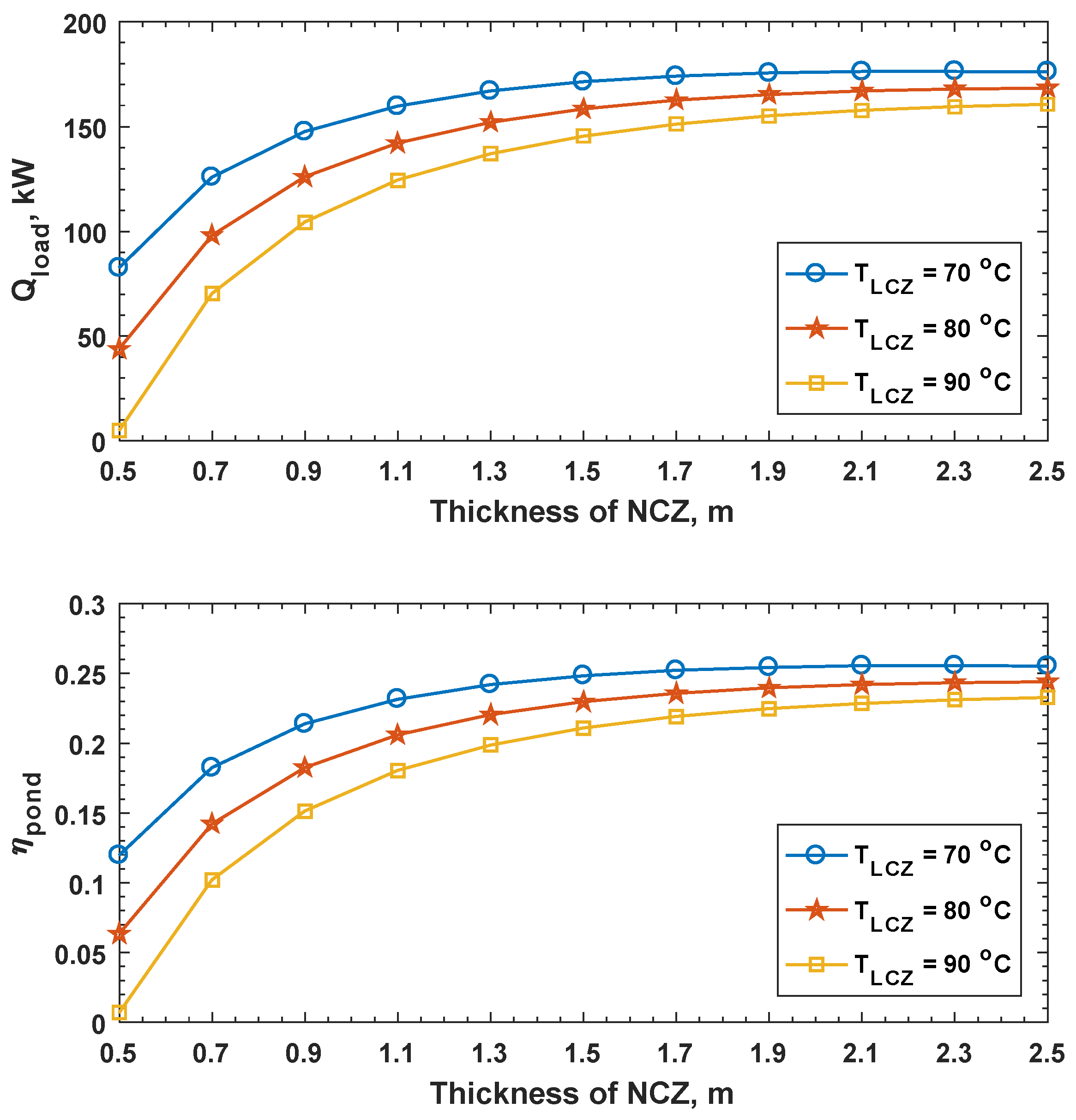
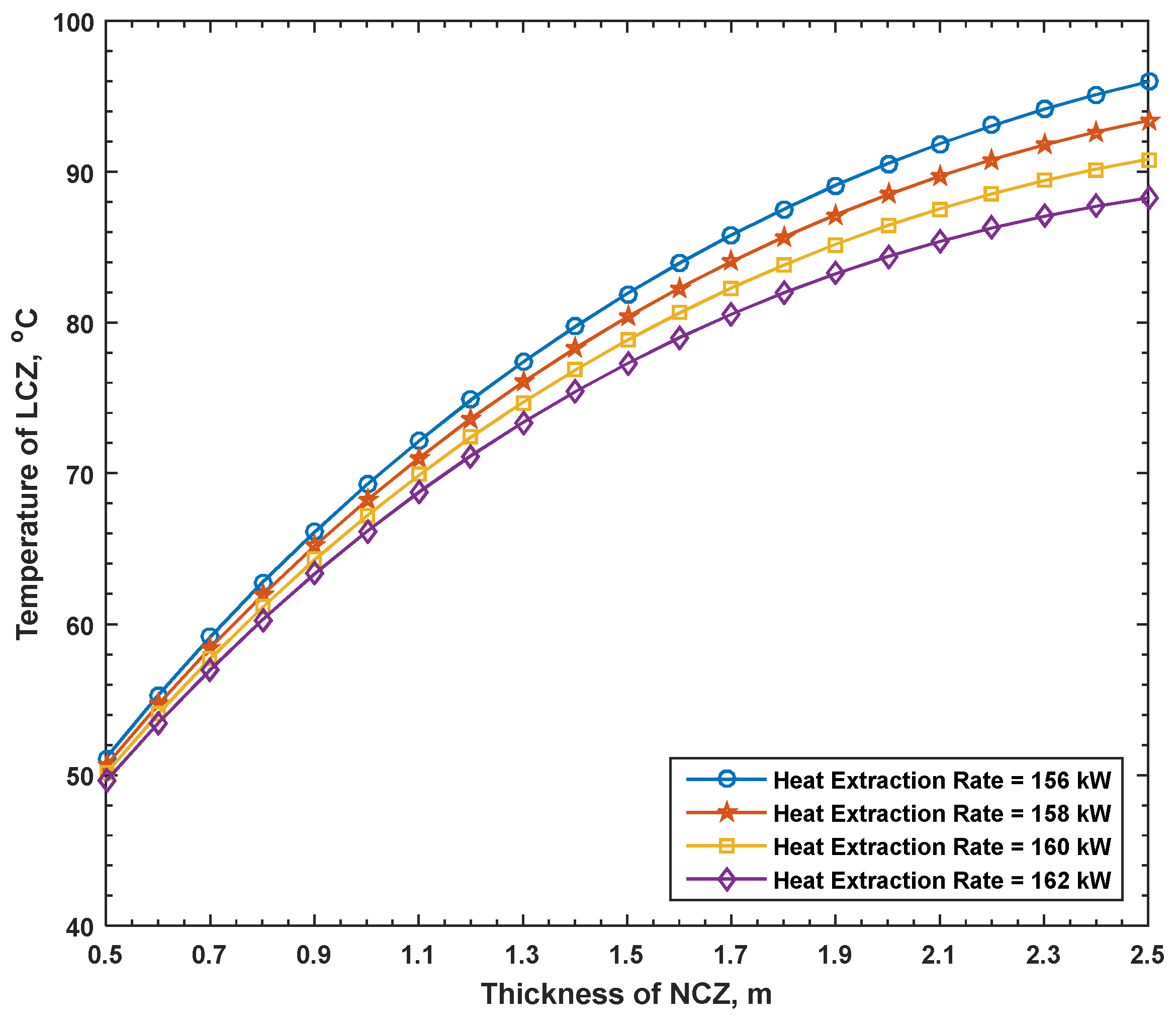
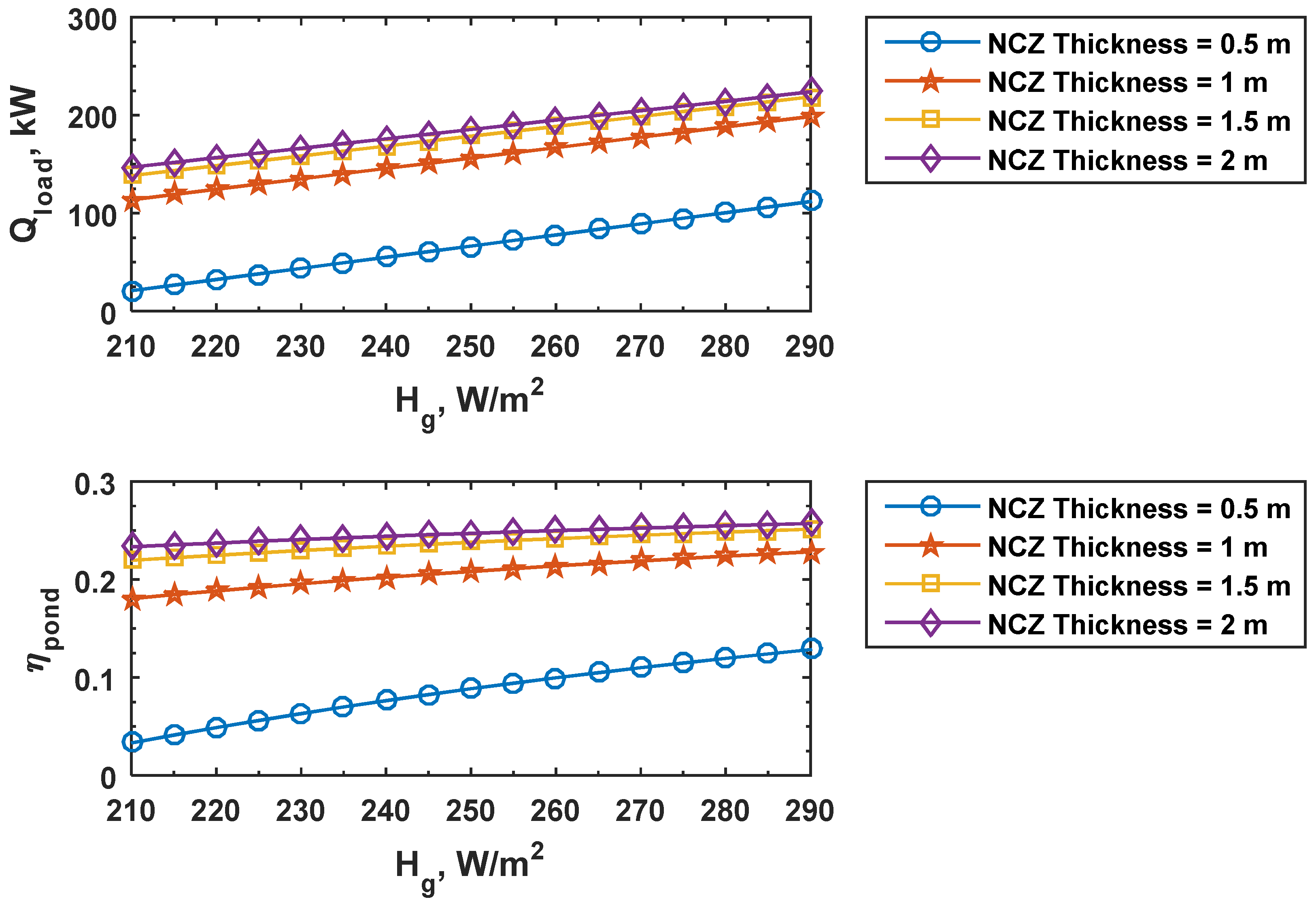

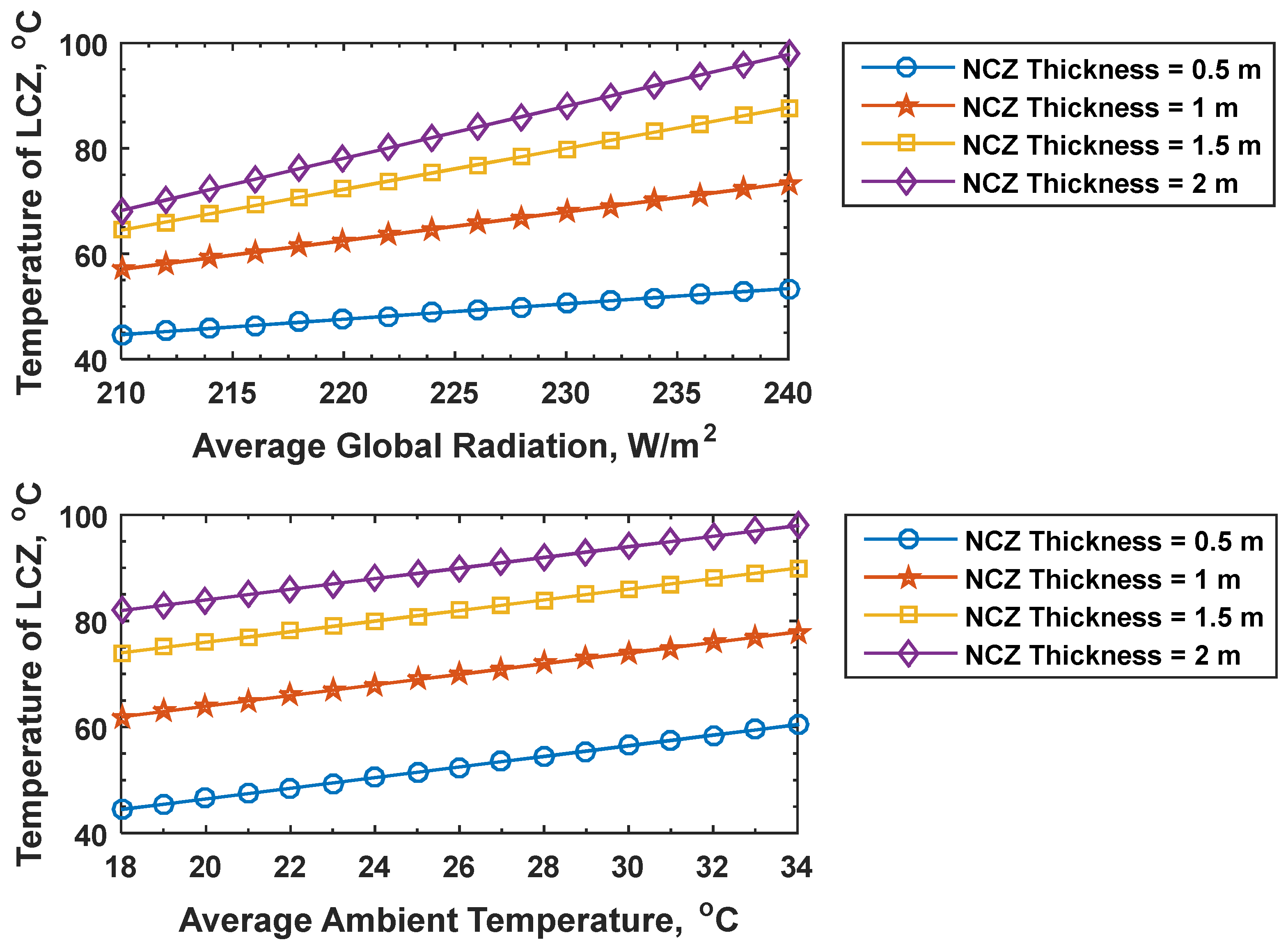
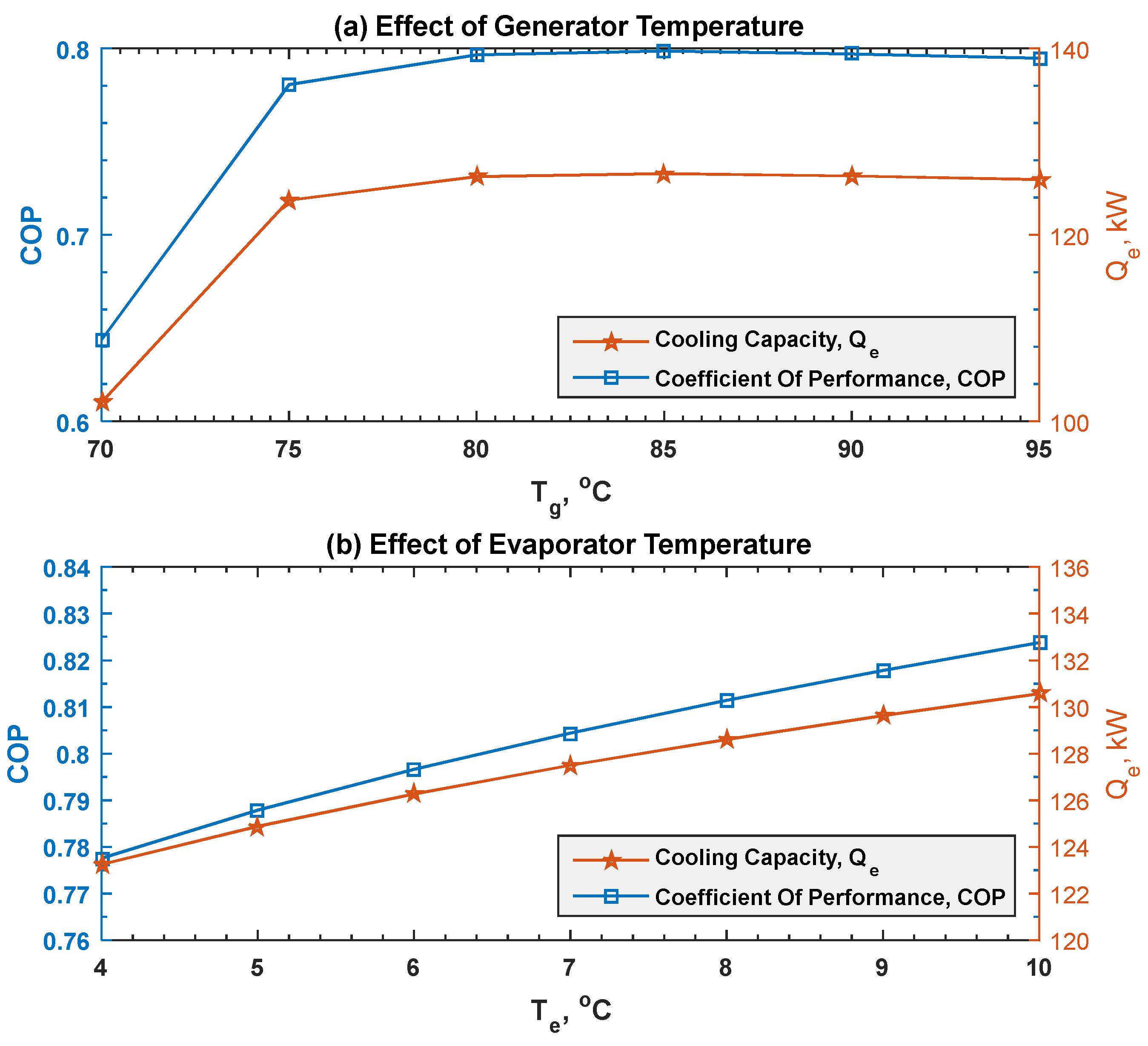
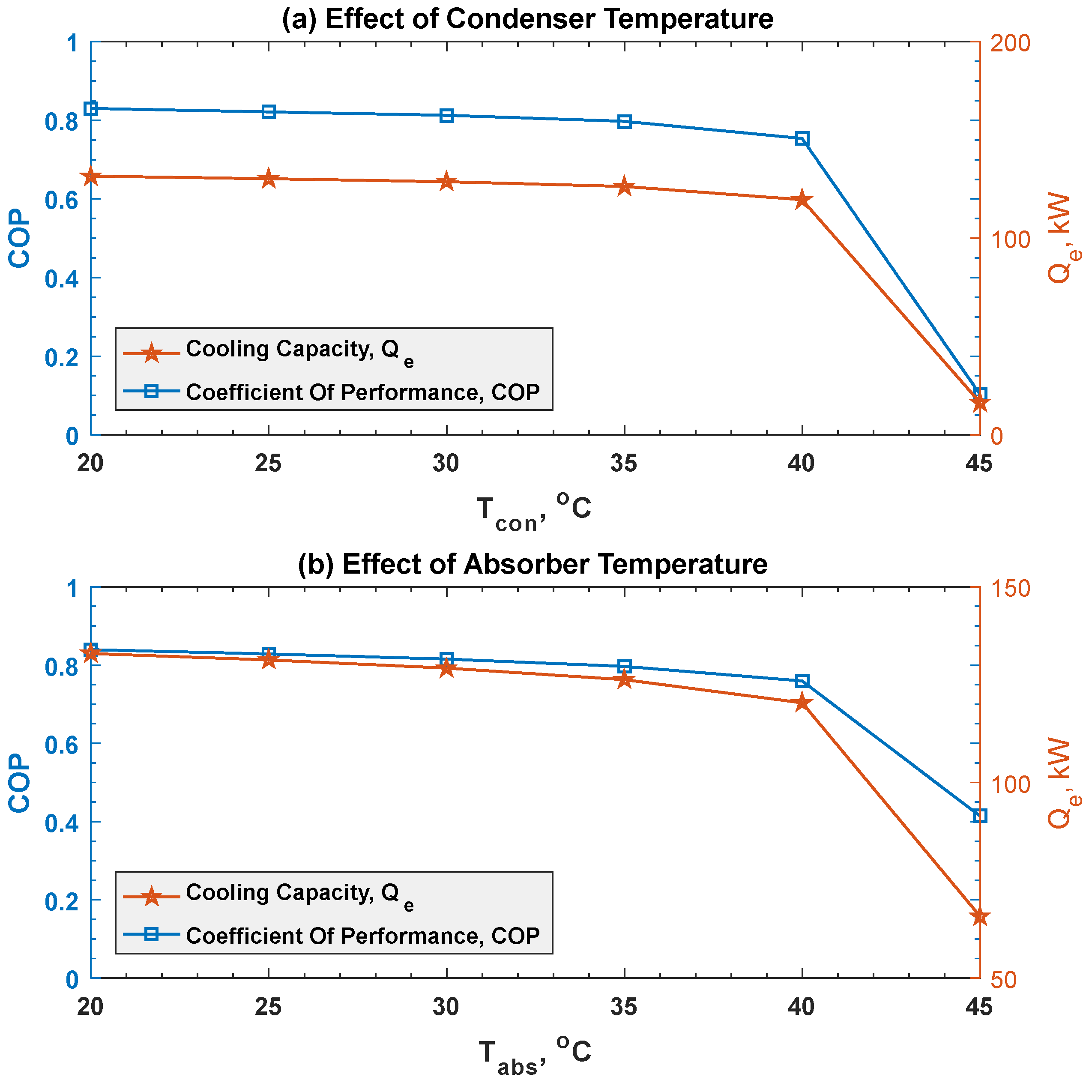



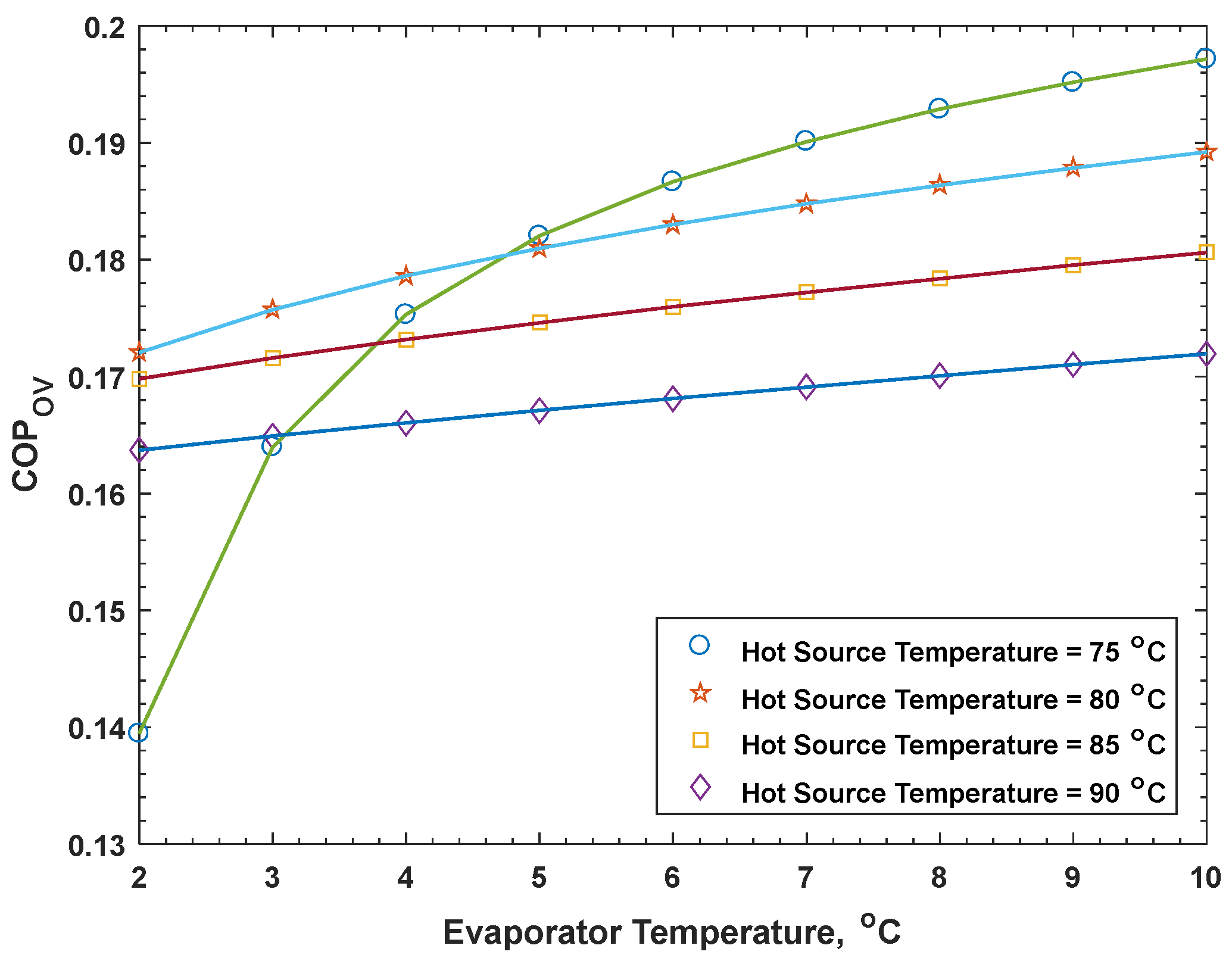

| Parameters | El Paso | Solvay Minerales | Kuwait City |
|---|---|---|---|
| Area | 3000 m2 | 500 m2 | 8 m2 |
| UCZ thickness | 0.7 m | 0.2 m | 0.2 m |
| NCZ thickness | 1.2 m | 1.4 m | 0.4 m |
| LCZ thickness | 1.35 m | 0.6 m | 0.3 m |
| Average global radiation | 5.7 kWh/m2·d | 4.87 kWh/m2·d | 5.4 kWh/m2·d |
| Average ambient temperature | 17.3 °C | 11.7 °C | 25.9 °C |
| Latitude | 31.773088 | 37.05 | 29.3759 |
| Longitude | −106.505730 | −3.75 | 47.9774 |
| Average LCZ temperature | 81.1 °C | 73 °C | 80.5 °C |
| UCZ temperature | 15.7 °C | 20 °C | 16.3 °C |
| Solar Pond | Experimental Average LCZ Temperature | Predicted Average LCZ Temperature |
|---|---|---|
| El Paso | 81.1 °C | 84.1 °C |
| Solvay Minerales | 73 °C | 73 °C |
| Kuwait City | 80.5 °C | 81.8 °C |
Publisher’s Note: MDPI stays neutral with regard to jurisdictional claims in published maps and institutional affiliations. |
© 2022 by the author. Licensee MDPI, Basel, Switzerland. This article is an open access article distributed under the terms and conditions of the Creative Commons Attribution (CC BY) license (https://creativecommons.org/licenses/by/4.0/).
Share and Cite
Saleh, A. Modeling and Performance Analysis of a Solar Pond Integrated with an Absorption Cooling System. Energies 2022, 15, 8327. https://doi.org/10.3390/en15228327
Saleh A. Modeling and Performance Analysis of a Solar Pond Integrated with an Absorption Cooling System. Energies. 2022; 15(22):8327. https://doi.org/10.3390/en15228327
Chicago/Turabian StyleSaleh, Ahmad. 2022. "Modeling and Performance Analysis of a Solar Pond Integrated with an Absorption Cooling System" Energies 15, no. 22: 8327. https://doi.org/10.3390/en15228327
APA StyleSaleh, A. (2022). Modeling and Performance Analysis of a Solar Pond Integrated with an Absorption Cooling System. Energies, 15(22), 8327. https://doi.org/10.3390/en15228327






